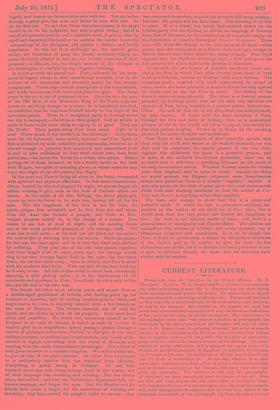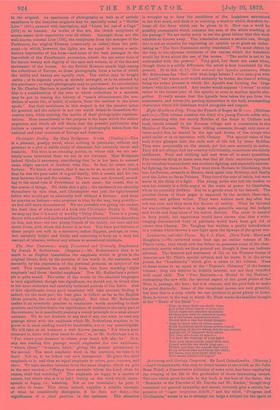CURRENT LITERATURE.
Photographs from the Collections in the British Museum. By S. Thompson. (London : W. A. Mansell and Co.)—Granted that museums aro useful institutions, it must also be admitted that the more widely their contents are made known the better. No means exist so proper for spreading such a knowledge as photography. The records produced in that way will, in most essentials, be the most accurate and complete, as well as the cheapest. But obvious as this appears, tho work has never been systematically attempted until now, and has been undertaken at last, as it should seem, by private enterprise. The introduction to the catalogue states that "the present collection of photographs has been made by the liberal sanction of the Trustees, and with the assist- ance of Mr. Winter Jones, the principal librarian," but so far as regards the cost of the undertaking, the Trustees have not interfered further than to stipulate (in favour of the public) that the price of each photo- graph shall not exceed the small maximum of two shillings. The series consists of nearly 1,000 plates, and is grouped into seven parts :—(1) Prehistoric and Ethnographical, (2) Egyptian, (3) Assyrian, (4) Grecian, (5) Etruscan and Roman, (6) Antiquities of Britain and Modiaaval Art, and (7) Seals of Sovereigns, eec. In selecting subjects from each department, assistance has been given by several well-known scholars and antiquaries employed at the Museum, and they have also com- piled the catalogue. The selection is full, and the photographs, all excellent, are often remarkably good specimens of the art. Hero are flint and ivory implements, and other relics of prehistoric times, with analogous objects now in use among savages ; Egyptian monuments, with their hieroglypical inscriptions, and the terra-cotta tablets of the Assyrians, as readable in the photograph (by those who know how) as
In the original. As specimens of photography as well as of artistic excellence in the Assyrian originals may be specially noted a "Marble Lion" (401), covered with inscription, and "Lions let out of a Cage" (474) to be hunted. As works of flue art, the Greek sculptures of course assert their superiority over all others. Amongst them are the well-known colossal Lion (724), the sculptures from the metopes of the Parthenon, the mighty Theseus (commonly so called) from the pedi- ment—in which, however, the lights are too equal to convey a satis- factory impression of the form—and some of the best passages in the baa-reliefs of the Parathenaic procession, where the eye never tires of the heroic beauty and dignity of the men and women, or of the fire and movement of the horses. As the British Museum stands high among the collections of Europe, so these photographs form a series of which the utility and beauty are equally rare. The series may be bought entire ; or in separate parts, as already arranged, or to be selected by the purchaser ; or single photographs may be purchased. An introduction by Mr. Charles Harrison is prefixed to the catalogue, and is devoted by him to a consideration of the uses to which collections in a museum may be pat in tracing the history of "man's advancement, the con- ditions of social life, of belief, of science, from the earliest to the latest epoch." But their usefulness in this respect is for the present taken for granted, and the subject is not one which demands immediate dis- cussion here, while noticing the merits of their photographic represen- tations. More immediately to the purpose is the hope which the author expresses, and which all will share, that the present publication may initiate a system of mutual exchange of photographs taken from the national and local museums of Europe and America.



































 Previous page
Previous page